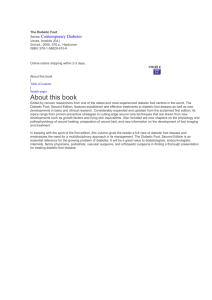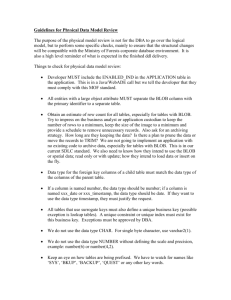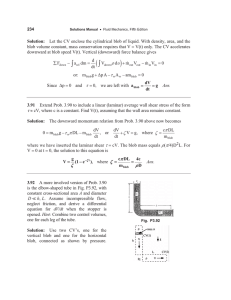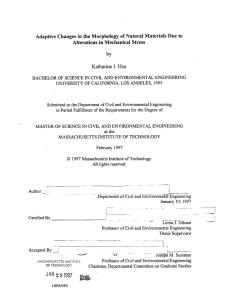- Edge Hill University
advertisement
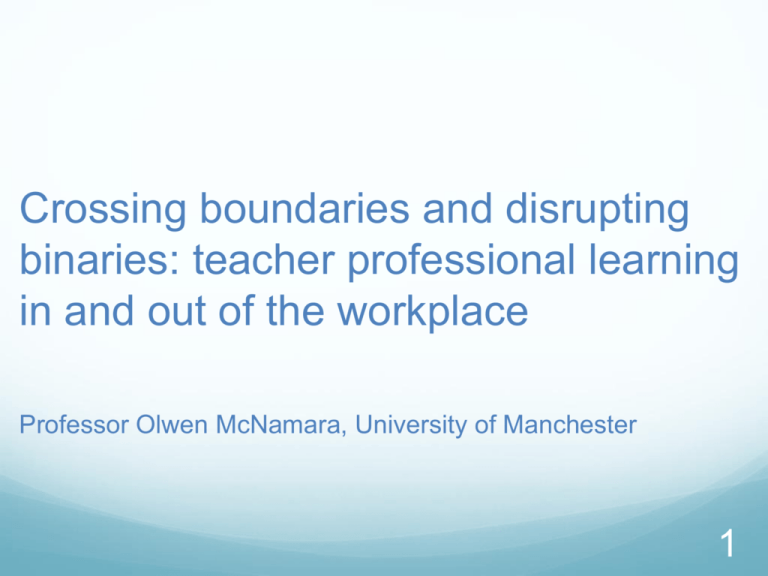
Crossing boundaries and disrupting binaries: teacher professional learning in and out of the workplace Professor Olwen McNamara, University of Manchester 1 The Importance of Teaching ‘what really matters is how we’re doing compared with our international competitors. That is what will define our economic growth and our country’s future. The truth is, at the moment we are standing still while others race past. In the most recent OECD [Organisation for Economic Co-operation and Development] PISA [Programme for International Student Assessment] survey in 2006 we fell from 4th in the world in the 2000 survey to 14th in science, 7th to 17th in literacy, and 8th to 24th in mathematics. The only way we can catch up, and have the world-class schools our children deserve, is by learning the lessons of other countries’ success.’ (Cameron and Clegg, DfE, 2010: 3) McKinsey Report The experiences of top school systems suggest that three things matter most: getting the right people to become teachers; developing them into effective instructors; and ensuring the system is able to deliver the best possible instruction for every child. These systems demonstrate that the best practice for achieving these three things work irrespective of the culture in which they are applied. They demonstrate that substantial improvements in outcomes is possible in a short period of time and that applying these best practices universally could have enormous impact in improving failing school systems, wherever they might be located. (McKinsey 2007: 5) Brief history of Initial Teacher Education 1850s Pupil-teacher (national) scheme and emergent (denominational) Colleges of Education to train elementary teachers 1870 Education Act sets the age for compulsory schooling to 10 (raised to 13 in 1899 and 14 in 1918) in England & Wales 1890s Day Training Colleges established in academic settings offer professional liberal education for teachers. to 1920s University Training Departments increasingly focus on year secondary elite and independent sectors one 1950s Training expansion in Colleges of Education follows school leaving age increase (to 15) and post war baby boom 1973 Demographic contraction leads to institutional mergers and facilitates mandatory training for all teachers 1984 Introduction of accreditation through CATE 1994 Establishment of OFSTED and TTA (to replace CATE) Day Training Colleges Trainee teachers studied standard academic subjects alongside professional subjects such as the history and philosophy of education and educational administration. DTC staff were keen that training should include a significant amount of classroom teaching. Manchester’s School Board proved supportive, opening its elementary schools to students, but there was an emerging consensus among educationists that the best experience was gained at so-called “demonstration schools”. These schools, usually administered directly or indirectly by the training colleges, were specially designed for trainee teachers to allow them to engage critically with the theories they had learnt in the lecture rooms through practical experience of teaching children. This concept had proved successful in Germany and the U.S.A, but Owens College, fearful of the administrative and financial burdens of running such a school, initially proved resistant to the idea. (http://archiveshub.ac.uk/data/gb133-fed.txt) TTA Annual Lecture There is no agreed knowledge-base for teachers, so they largely lack a shared technical language…. It was once hoped that the so called foundation disciplines of education psychology, sociology, philosophy, and history - would provide the knowledge-base …. Unfortunately, very few successful practising teachers themselves had this knowledge-base or thought it important for practice. It remains true that teachers are able to be effective in their work in almost total ignorance of this infrastructure. … the disciplines of education are seen to consist of “theory” which is strongly separated from practice. Trainee teachers soon spot the yawning gap between theory and practice and the low value of research as a guide to the solution of practical problems’ (Hargreaves, 1996:2). To Review The politicisation of teacher education resulted in an increasing lack of professional control for training providers and left the sector subject to short-termism and the vagaries of political ideology. The intrusiveness of policy requirements, regulation and accountability restricted the levels of professional engagement, engendered a technical–rational approach and created a culture of compliance The proliferation of reductionist and task-focused partnership arrangements endemic across the sector as a whole (Childs et al, 2014). Demographic downturn in secondary phase and non-ITE related factors threaten sustainability of Education Departments and mean the sector is unable to contribute its full potential to teacher learning and school improvement. Teaching Schools Teaching Schools are part of the government’s drive to give schools more freedom and to enable them to take increasing responsibility for managing the education system. They are tasked to lead a wider ‘Alliance’ of schools to: Plan and lead a high-quality school-based initial teacher education provision. Plan and lead a high-quality professional and leadership development. Identify local succession planning strategies & develop leadership potential. Provide support for other schools and plan for and meet school improvement needs identified locally. Recruit, manage and quality assure specialist leaders of education. Develop evidence-informed practices and school improvement strategies by engaging in and with research. The Blob There are millions of talented young people being denied the opportunity to succeed as they deserve. Far too many are having their potential thwarted by a new set of Enemies of Promise… politically motivated individuals who have been actively trying to prevent millions of our poorest children getting the education they need … they are all academics who have helped run the university departments of education responsible for developing curricula and teacher training courses”. “The Blob – the network of educational gurus in and around our universities who praised each others’ research, sat on committees that drafted politically correct curricula, drew gifted young teachers away from their vocation and instead directed them towards ideologically driven theory… In the past The Blob tended to operate by stealth, using its influence to control the quangos and committees which shaped policy. But The Blob has broken cover in the letters pages of the broadsheets because this Government is taking it on…We have abolished the quangos they controlled. We have given a majority of secondary schools academy status so they are free from the influence of The Blob’s allies in local government. We are moving teacher training away from university departments and into our best schools. And we are reforming our curriculum and exams to restore the rigour they abandoned. (Gove, Mail on Sunday, March 24th 2013) 21st century workplace Role of the teacher work alongside paraprofessional, with multi-professional and multi-agency teams Work as hybrid educators across school boundaries and between schools and universities Learning context Disparate curricular and assessment practices Organisational space Deregulation of pay & condition of service and requirement for teacher certification Boundaries blurred by different designations of schools Complex and diverse governance arrangements Apprenticeship: training for a 21st century workforce? Training model (Apprenticeship): An adaptive model predicted on induction into community of practice by learning about and replicating teacher behaviours, activities and identities in particular schools Training need: A developmental model based on reflection and enquiry in order that teacher can develop and extend their skill set to afford then mobility within the system. ‘a new generation of expertise, not based on supreme and supposedly stable individual knowledge and ability, but on the capacity of working communities to cross boundaries, negotiate and improvise’ Engeström (2004, p. 145) Disrupting binaries knowledge for practice (formal knowledge) knowledge in practice (practical knowledge) knowledge of practice (‘working within the contexts of inquiry communities to theorise and construct their work and to connect it to the larger social, cultural and political issues’) (p 250) ‘maintain the hegemony of university generated knowledge for teaching… These implications serve to reify divisions that keep “teachers in their place” – the separation of practitioners from researcher, doers from thinkers, actors from analysts, and actions from ideas’ ((Cochran-Smith and Lytle 1999: 289). Metaphors for Teacher Learning ‘Learning as Acquisition’ (standard paradigm) ‘focus on mind’ (that positions learning as both the process of acquisition and product acquired); ‘interiority’ (that positions learning as internal to the mind and valuable in and of itself rather than seeing its value in its applicability); and ‘transparency’ (that positions learning as clear and unambiguous) (Hager, 2004: 243–44). ‘Learning as Participation’ (dominant metaphor in workplace learning) (Sfard, 1998) A senior resident, who is supervising Sarah, is working in the hospital but at the end of a phone, and the specialist who is providing ‘cover’ to them both is doing so by telephone from home. It is a busy shift, not least because Sarah has repeatedly been paged by the nursing staff on a ward, where a patient who is not in command of his faculties has been abusing nurses. They are demanding that ‘a doctor does something’ to calm the patient down. That would pose the most experienced doctor, let alone Sarah, a practical and ethical challenge. Meanwhile, she is called to see a patient in the emergency department who has diabetes and a sore on his foot. She knows diabetic foot ulcers can ultimately lead to amputation if they are not handled quickly and appropriately on occasions like this one. She tries to recall teaching she received as a medical student. The action she must take is influenced by a judgment as to whether or not the blood supply to the patient’s foot is seriously impaired but how, exactly, does one do that? She must also get an X-ray of the foot to determine if the underlying bone is infected; how, she tries to remember, will she make that judgment when she examines the X-ray. Should she call the senior resident now, later or not at all? The senior resident she is reporting to today has a reputation for making harsh judgments on juniors who ‘bottle out’ too quickly, but what will the specialist covering them both say if Sarah shows herself unwilling to call for help when in doubt? Should she go ‘over the head’ of the senior resident, or will that cause even more trouble? Perhaps there is a doctor on call for the diabetes department; how does she find that out? She should probably admit the patient to hospital, but should it be to a medical or surgical ward? If a surgical ward, is it the local practice for such patients to go to a general surgical, orthopedic, or vascular ward? She should start antibiotics to treat infection in the foot. Is there a protocol that dictates which antibiotics are to be used in this hospital? There goes her pager again from the ward with the abusive patient. You just don’t learn in medical school how to manage patients with diabetic foot problems and you don’t learn to do so properly ‘on the job’ unless you do a diabetic job, which not everyone does. Even then, you find Dr X likes his patients managed one way and Dr Y another. They don’t get on well with one another so you get yelled at for making the wrong decision if you don’t first find out if the patient’s specialist is Dr X or Dr Y. Why, oh why, did she have to get a diabetic foot, which she’s clueless about, at a moment like this, rather than something straightforward like pneumonia? (Dornan & Morcke, 2014) Early Career Learning CONTEXT FACTORS Allocation & structuring of work Minimal induction/transitional LEARNING FACTORS Challenge and value of work High levels of challenge requiring arrangements ‘Pressure cooker’ environment Multiplicity of tasks/prioritisation critical Competing imperatives Relationships at work Contradictory demands from line mangers Complex supervisory and other relationships within teams Multiple brief contacts with other professionals Participation and expectation Overwork the norm Ultimate (sole) responsibility Transition/induction problems often underestimated evidence-based judgements as well as technical skills Complex relationships with staff/othe professionals/pupils High value for patients/pupils/parents Feedback Supervision/mentoring/access to training critical, often variable Learning culture critical and often variable Emotional support critical and not always forthcoming Confidence and commitment Strong commitment to patients/ pupils Early loss of confidence Building resilience demands skilled support Derived from Eraut (2014) To conclude (1) Establishing an open and collegiate learning culture in which the status of teachers as learners is endorsed and celebrated and different development stages recognised; (2) Creating ‘third’ space learning where new knowledge can be generated through enquiry in a symbiotic relationship between the multiple discourses about theory and practice and teaching and learning; (3) Providing a well-planned, rich portfolio of expansive activities offering a balance of organisational and individual needs; (4) Making time and space available for quality learning opportunities and experiences to occur and to be reflected upon; (5) Nurturing a cadre of hybrid teaching colleagues to undertake the roles of expert mentors/coaches to facilitate learning and support the development of emotional and psychological resilience.
